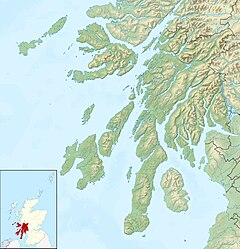| This article needs additional citations for verification. Please help improve this article by adding citations to reliable sources. Unsourced material may be challenged and removed. Find sources: "Arrochar, Argyll" – news · newspapers · books · scholar · JSTOR (October 2011) (Learn how and when to remove this message) |
Arrochar
| |
|---|---|
 Arrochar with Ben Lomond behind, taken from the path to The Cobbler. Arrochar with Ben Lomond behind, taken from the path to The Cobbler. | |
 | |
| OS grid reference | NN 29700 04300 |
| Council area |
|
| Lieutenancy area |
|
| Country | Scotland |
| Sovereign state | United Kingdom |
| Post town | Arrochar |
| Postcode district | G83 |
| Dialling code | 01301 |
| UK Parliament |
|
| Scottish Parliament |
|
| 56°12′03″N 4°44′48″W / 56.200743°N 4.7467273°W / 56.200743; -4.7467273 | |
Arrochar (/ˈærəxər/ ARR-ə-khər; Scottish Gaelic: An t-Àrchar [ən̪ˠ t̪aːɾəɾ] or An Tairbeart an Iar) is a village located near the head of Loch Long, on the Cowal Peninsula, in Argyll and Bute, Scottish Highlands. The Arrochar Alps are named after the village. The village is within the Loch Lomond and The Trossachs National Park.
Historically in Dunbartonshire, it is overlooked by a group of mountains called the Arrochar Alps, and in particular by the distinctive rocky summit of the Cobbler. It enjoys good communications as it is at the junction of the A83 and A814 roads and is served by Arrochar and Tarbet railway station. In addition the A82 road runs through Tarbet two miles (three kilometres) east.
For over five centuries this area, the feudal barony of Arrochar, was held by the chiefs of Clan MacFarlane and before them by their ancestors the barons of Arrochar. The family is Celtic in the male line and native to their Highland homeland of tall peaks and deep lochs just above the waist of Scotland. The settlement was a key target for Viking raiders who took their boats two miles (three kilometres) overland to Tarbet to attack the unprotected inland settlements at Loch Lomond before their defeat in 1263 at the battle of Largs.
The western end of Arrochar marks the traditional boundary of Argyll and Dunbartonshire, and this remained the case under local government reorganisation in 1975. However, in 1996 the boundaries of Argyll and Bute and West Dunbartonshire were substantially redrawn, bringing the whole area into Argyll and Bute.
Arrochar Torpedo Testing Facility

The photograph shows the former torpedo testing facility at the head of Loch Long. It was decommissioned in 1980 and is currently part demolished. Demolition has been stalled since a fire on the site in June 2007.
Torpedoes were fired up Loch Long from tubes at the front of the facility. A boat stood by to recover the (unarmed) torpedoes where they were returned for analysis. The now roofless shed to the left and the main part of the building have tracks where torpedoes were stored and worked on. Hoists on the first floor lowered the torpedoes into the tubes.
The control room at the top looking straight down the loch housed a camera. Behind the control room, above the loading shed, is office accommodation. The rest of the facility included housing and workshops but these have been sold off.
See also
References
- "Archived copy" (PDF). Archived from the original (PDF) on 14 June 2019. Retrieved 17 January 2017.
{{cite web}}: CS1 maint: archived copy as title (link) - "Loch Lomond Archaeology". Archived from the original on 15 August 2007.
- Steve Partridge (2007). "Arrochar Torpedo Testing Facility:: OS grid NN2803". Geograph British Isles. Retrieved 26 November 2007.
External links
- Map sources for Arrochar, Argyll
- The Official Homepage of the International Clan MacFarlane Society, Inc.
- Arrochar, Tarbet and Ardlui History - website
- Three Villages Community - website.
- The Loch Lomond and The Trossachs National Park - website
- Video footage of the old Arrochar Pier
- Video footage of Arrochar & Tarbet railway station